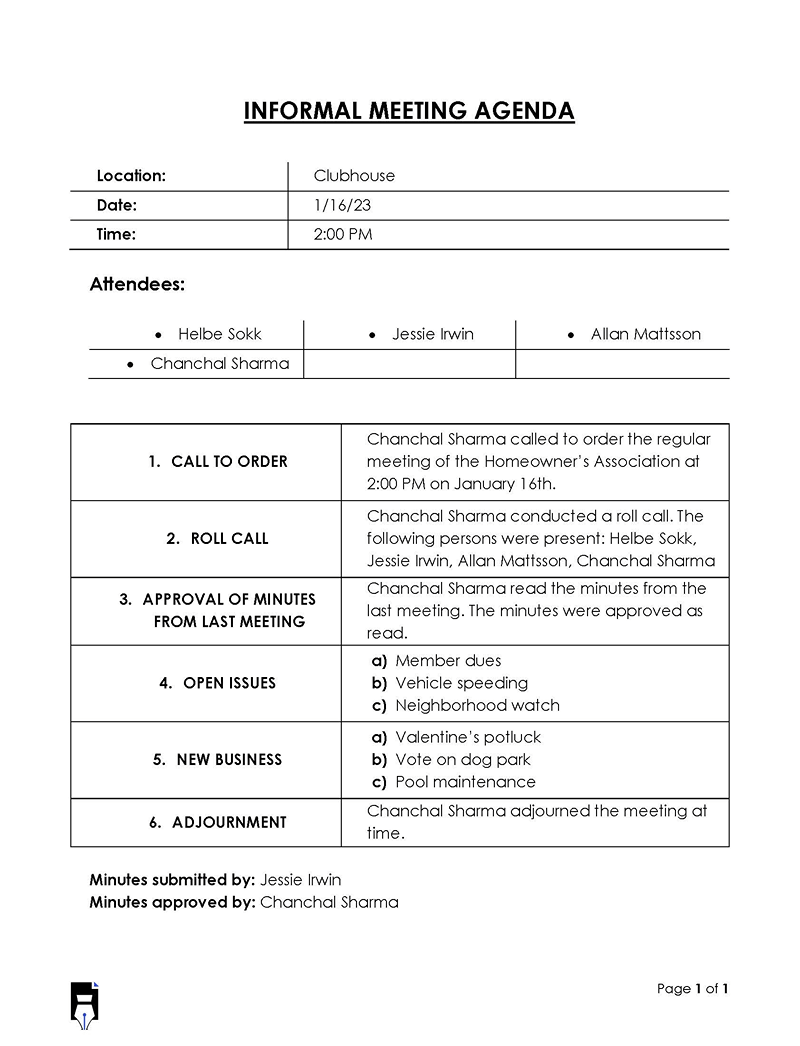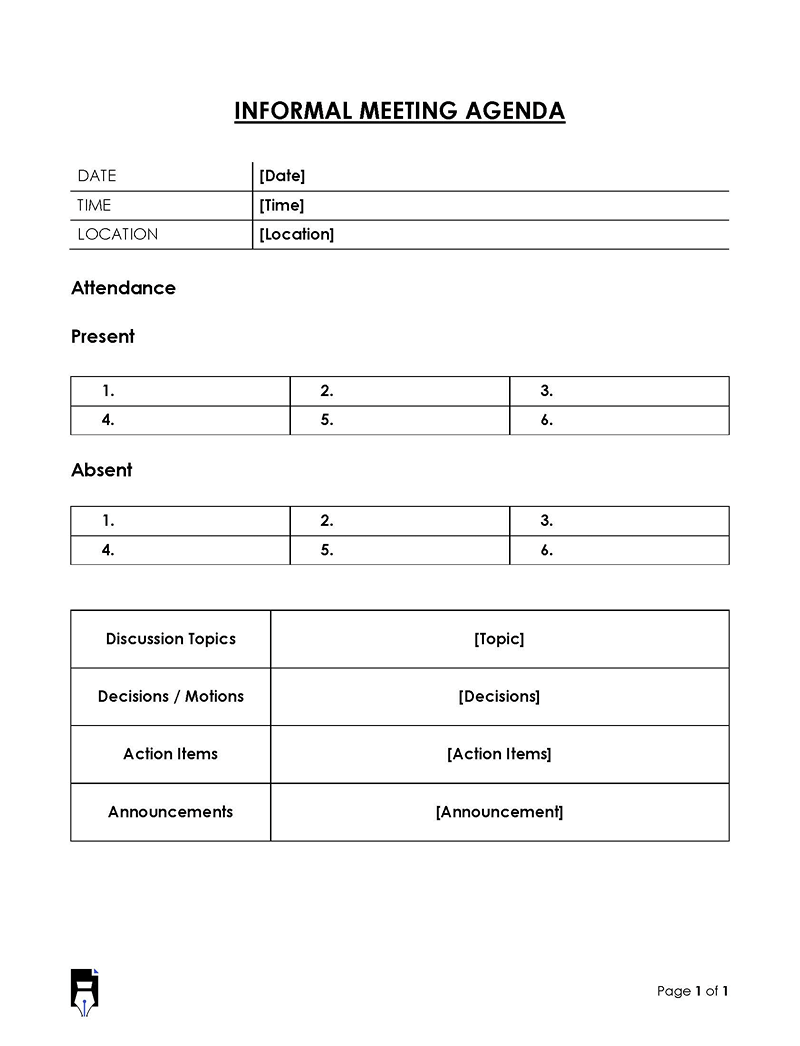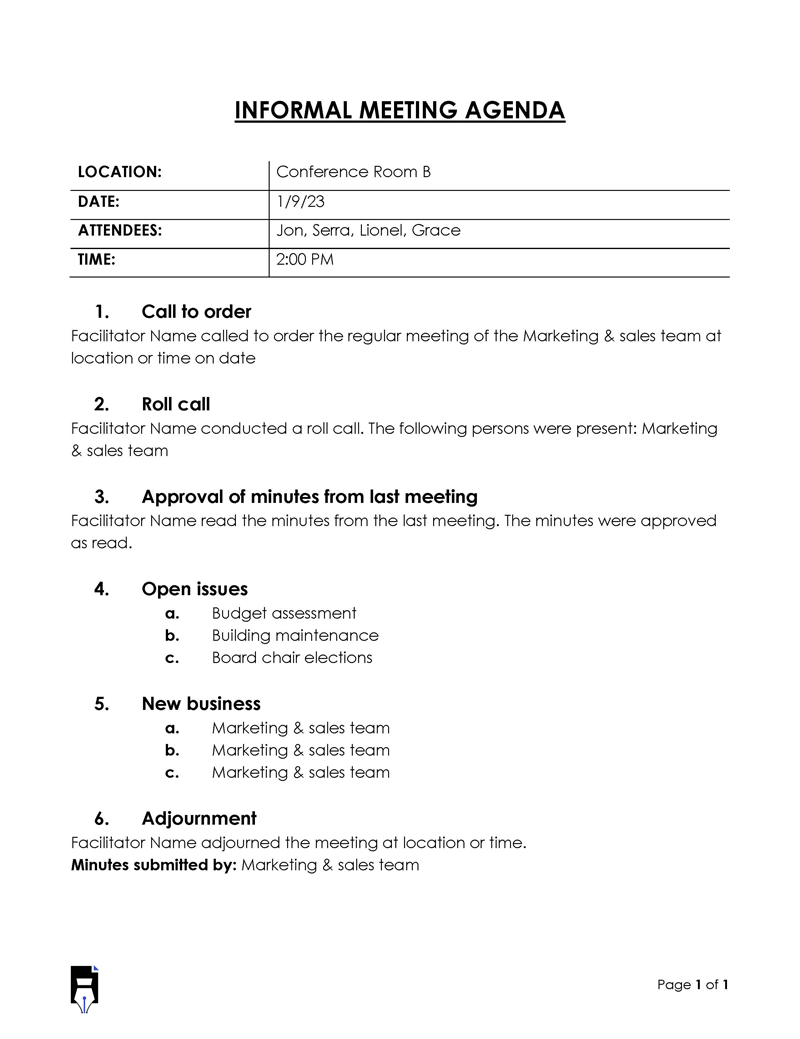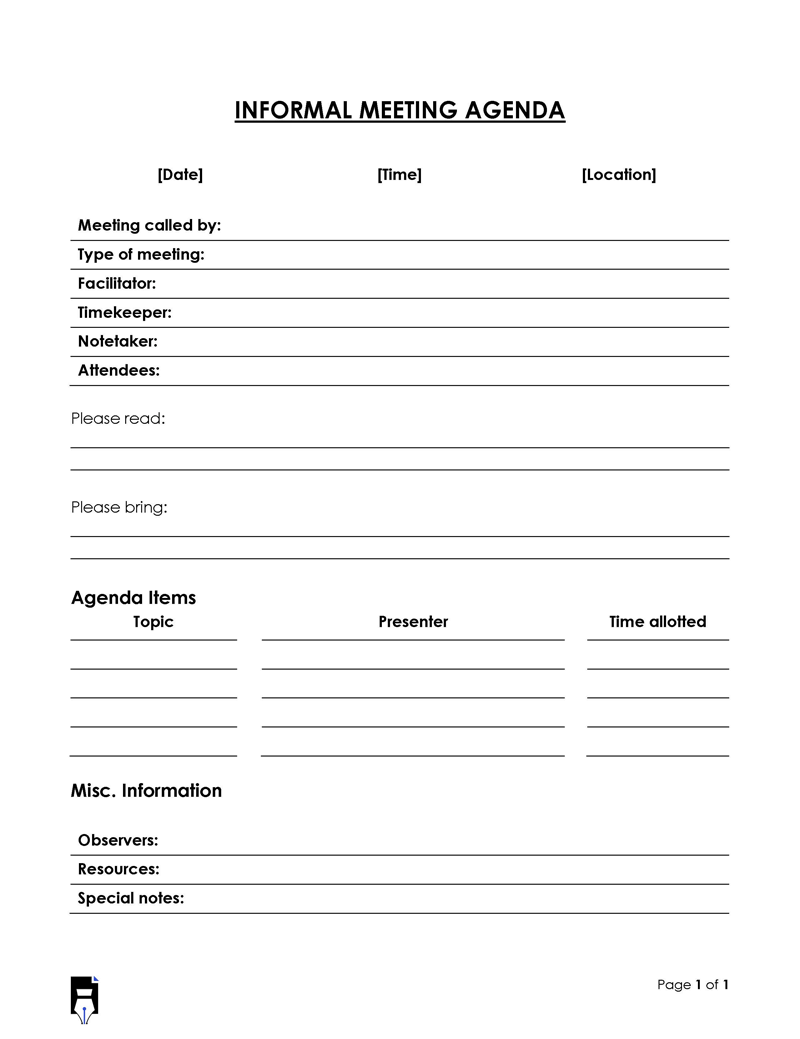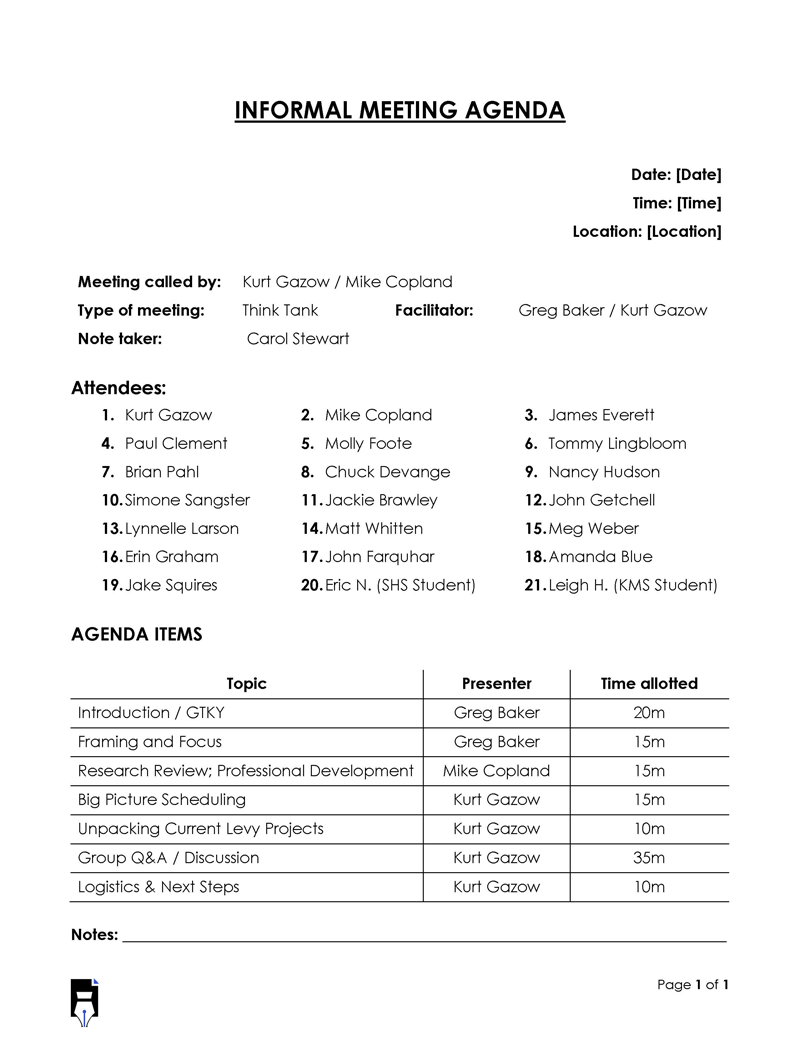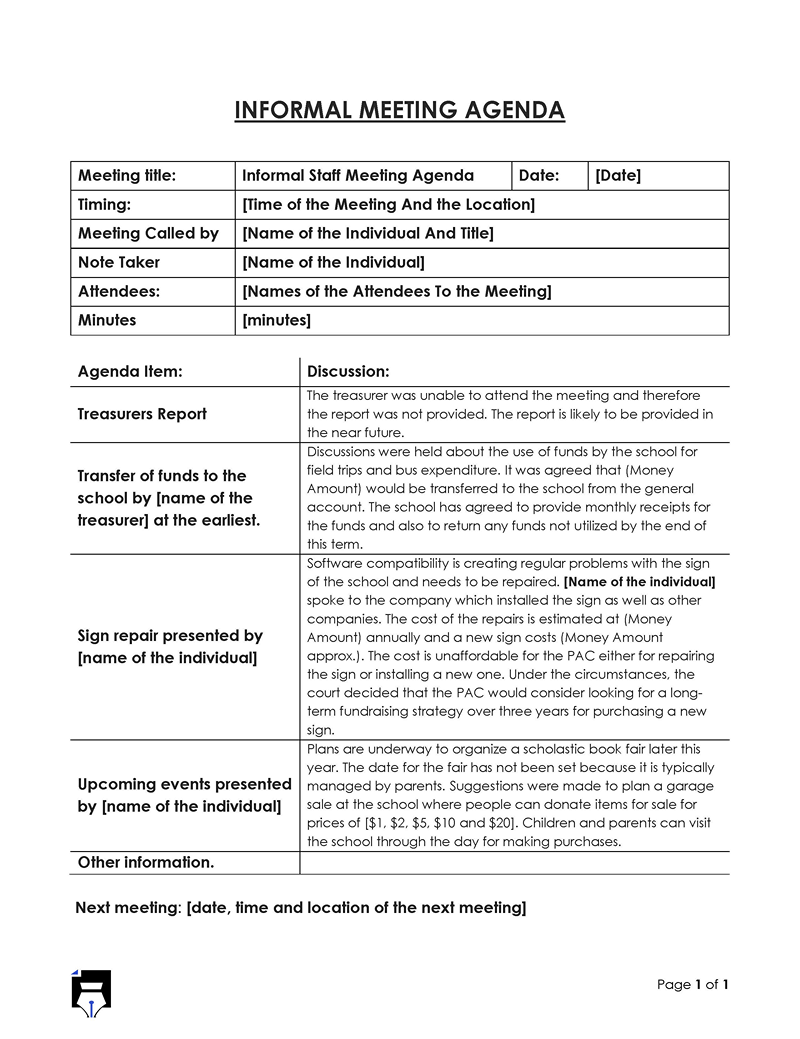An informal meeting is usually less planned and takes place in a casual setting compared to a formal one. Although it may have a loose agenda, attendees are more likely to go “off script” and free to speak whenever they want. An informal meeting agenda template is used to provide structure and organization to informal meetings. These meetings are typically held in a relaxed environment, such as a restaurant or at one of the attendees’ preferred locations, as opposed to formal meetings, typically held in boardrooms.
Examples of informal meetings include:
- Brainstorming sessions
- Post-formal meeting discussions
- Training sessions
Even though these meetings do not necessitate formal minutes, keeping a record is a good practice. An informal meeting agenda is an outline that lists and schedules the subjects to be addressed during the meeting. It may lack distinguishing features such as a chairperson, minutes, and a set agenda. This agenda provides written documentation that can be referred to later.
This article will address the significance of an informal meeting agenda template and provide a step-by-step guide on making one. Free downloadable templates have also been provided to simplify tracking each topic’s discussion topics, speakers, conclusions, action items, and timeframes.
Download Free Templates
Following are the meeting agenda templates that you can download for free:
Why Every Workplace Needs to Make Informal Meeting Agendas
An agenda assists the attendees in preparing for an informal meeting and navigating the topics to be discussed. It enables participants to be aware of agenda items and actively engage in appropriate discussions. It is frequently used when there is little time to organize a formal meeting and no regulations for the discussion format.
It helps increase productivity and engagement. Attendees will contribute more since they have been prepared. Consequently, the quality of the meeting will improve. Furthermore, people are more likely to attend the meeting if they know the topics to be addressed.
An agenda ensures that every attendee is on the same page regarding the objectives of the meeting. Every attendee’s concerns and opinions will be voiced, and quieter employees will be more inclined to contribute to the discussion given its loose setting. It can help them address topics based on priority and make decisions more quickly.
Finally, an agenda ensures that all decisions reached during the discussion are accomplished, and that action points are executed as required.
How to Make Agenda for Informal Meeting
Whether your meeting will take thirty minutes or half a day, you should have a well-planned agenda. The layout of your agenda should be simple so that anyone referring to it in the future can easily capture the following:
- decisions made,
- next steps,
- action items and who is responsible.
To create an agenda for an informal meeting, you can follow the step-by-step guide below:
Step 1: Formatting the agenda
Identify the purpose of your meeting and list the key agenda items. Each agenda item should be related to the objectives you seek to achieve with your informal meeting. List the attendees, then specify the time and location the meeting shall take place. Seek the attendees’ input to ensure your meeting also fulfills their needs.
Estimate the time needed to discuss each topic and allocate each item a timeslot. This ensures you have enough time to cover the topics on your meeting agenda. Identify each attendee according to their discussion item to ensure your meeting runs smoothly.
The agenda may take the structure shown below:
[Date]
Attendees
-Attendee 1
-Attendee 2
Agenda
-Topic 1
[Key Discussions]
[Decisions Made]
[Next Steps]
-Topic 2
[Key Discussions]
[Decisions Made]
[Next Steps]
Next steps
-Action Item 1
Team Member Responsible: ________
Deadline: ________
Action Item 2
Team Member Responsible: ________
Deadline: ________
Finally, should attendees need to present any updates or reports during the meeting, send the agenda beforehand to give them ample time to prepare.
Step 2: Review minutes from the previous meeting
Examine the minutes from the previous informal meeting and make any necessary changes. This is a summary of who was present at the meeting, who was absent, what topics were discussed, and the results of the decisions. You may need to include additional information or elaborate on concerns raised during your previous informal meeting.
Also, ensure that all decisions, tasks, and action items that attendees were delegated to complete are documented. Your first agenda item should summarize action items yet to be completed and updates on their progress.
Step 3: Share the housekeeping items
Having colleagues in an informal setting presents a good opportunity to share routine information. Housekeeping items can include introductions, greetings, and any apologies for absence by other attendees, company news, or bulletins. It may also include approval of the previous minutes and any issues that arose from them that still need to be addressed elsewhere on the agenda. If you keep separate notes, housekeeping can be a separate item on your list. You can, however, include them on the agenda to ensure attendees remember to note them.
Step 4: Discuss the topics of new business
Every business topic that must be addressed should be added to the agenda as a new item. List the key points of discussion in bullet points, along with the anticipated results, which are the outcomes of the meeting. If there is a highly sensitive discussion item on the agenda that does not contribute to the purpose of the meeting, you can postpone it for future deliberation. Every agenda item should reflect what you hope to achieve when the meeting concludes. This could be the agreement on a topic, the submission of a report, or a vote.
These topics can be presented in the agenda as shown below:
Agenda Item #[Number]
- Summary of the discussion around the topic
- Specify if any motions were made
- List follow-up actions, names, and deadlines
Step 5: Set aside time for an open session
All informal meetings should have time for attendees to raise concerns that may be affecting them. This presents an opportunity to learn about their obstacles, accomplishments, and other difficulties they may be experiencing. It is worth noting that although this can be a chance for attendees to suggest items for future agendas, it can also negatively impact the meeting flow.
Therefore, concerns should be shared conservatively. Discussing alternative approaches can often help overcome challenges that the attendees may be experiencing.
Step 6: Summary of the meeting
The meeting should end with a review of each agenda item. This will assist attendees in understanding the decisions that were agreed upon during the meeting. This will also ensure that the attendees undertake the necessary action items following the meeting. Ensure everyone is involved in the review process and solicit their feedback on the positive and negative aspects of the meeting. This information can help you improve your next meeting.
Note: If the above mentioned process seems challenging, you can download any of our templates to simplify matters. They provide numerous alternatives for organizing your agenda items. They are easy to customize and allow you to note valuable information and related action items.
Conclusion
Informal meetings with a loose agenda result in faster decisions and more engaged attendees. Including the items to be addressed and the time allotted to each item is essential when creating your agenda. Ensure your agenda is versatile so it can be modified during the meeting. Finally, remember to indicate who will address each agenda item so that attendees can prepare beforehand.
A template can help you structure your informal meetings, especially if you lack time to prepare. By utilizing one of our templates, your participants will keep their focus on the topic areas that need to be addressed rather than the format of the meeting. Feel free to download one of our free templates and have a clear picture of how to draft an agenda for an informal meeting with a practical format.
